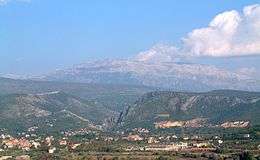Momčilo Đujić
| vojvoda Momčilo Đujić | |
|---|---|
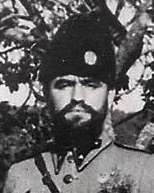 | |
| Native name | Момчило Ђујић |
| Nickname(s) | Father Fire |
| Born |
27 February 1907 Kovačić, Knin, Kingdom of Dalmatia, Austria-Hungary |
| Died |
11 September 1999 (aged 92) San Diego, California, United States |
| Allegiance |
|
| Years of service | 1941–1945 |
| Rank | vojvoda |
| Commands held |
|
| Battles/wars | World War II in Yugoslavia |
| Awards | |
| Other work | Ravna Gora Movement of Serbian Chetniks |
| Signature |
|
Momčilo Đujić (Serbian Cyrillic: Момчилo Ђујић, Serbo-Croatian pronunciation: [mǒmːtʃiːlo dʑûːjitɕ]; 27 February 1907 – 11 September 1999) was a Serbian Orthodox priest and Chetnik commander (Serbo-Croatian: vojvoda, војвода) who led a significant proportion of the Chetniks within the northern Dalmatia and western Bosnia regions of the Independent State of Croatia during World War II. After the assassination of King Alexander of Yugoslavia in 1934, he joined the Chetnik Association of Kosta Pećanac. After the invasion of Yugoslavia, he defended local Serbs against the Croatian fascist Ustaše regime and collaborated with the Axis powers against the Communist-led Yugoslav Partisans throughout the remainder of the war as the commander of the Chetnik Dinara Division. He survived the war, surrendering to the western Allies and eventually emigrating to the United States. He was tried and convicted in absentia for war crimes by the Yugoslav government, including collaboration and responsibility for the deaths of 1,500 people during the war.
Settling in California, Đujić played an important role in Serbian émigré circles and founded the Ravna Gora Movement of Serbian Chetniks alongside other exiled Chetnik fighters. He later retired to San Marcos, where he wrote poems and jokes that were published in both the United States and Serbia. He was instrumental in perpetuating Chetnik ideas in the Yugoslav Wars and controversially appointed Vojislav Šešelj as a Chetnik vojvoda in 1989. In 1998, Đujić said that he regretted awarding the title to Šešelj on account of his involvement with Slobodan Milošević. On 21 May 1998, Biljana Plavšić, President of the Republika Srpska at the time, awarded him the Order of the Star of Karađorđe (First Class). Đujić died at a hospice in San Diego in 1999, aged 92.
Early life, education and priesthood
Momčilo Đujić was born in the village of Kovačić, near Knin in the Kingdom of Dalmatia, on 27 February 1907. He was the oldest of five children born to Rade Đujić and his wife Ljubica (née Miloš).[1] The family was of Bosnian origin.[2] Rade had moved to Kovačić with his disabled veteran father, Glišo, and his brother, Nikola, in the late 1880s and lived off his father's Austro-Hungarian Army pension for a time. Ljubica hailed from the village of Ljubač, southeast of Knin. Shortly after his marriage to Ljubica, Rade established himself as a successful farmer. The couple went on to have three sons and two daughters.[1]
Đujić's mother originally intended to name him Simo, after his uncle. Đujić's father disliked the name and, having been raised listening to the gusle and reciting Serbian epic poetry, named his son after Momchil, a 14th-century brigand in the service of Serbian Emperor Dušan the Mighty.[1] Đujić finished primary school in 1918 and graduated as the best student in his class. Between 1920 and 1924, he attended lower gymnasium in Knin. After a two-year pause, he began attending the higher gymnasium in Šibenik but did not graduate. In 1929, he began attending the Serbian Orthodox seminary in Sremski Karlovci, graduated in 1931 and was ordained a priest two years later.[3] He was assigned to the Orthodox parish in Strmica, near Kovačić. Shortly after, he married Zorka Dobrijević-Jundžić, the daughter of a wealthy merchant from Bosansko Grahovo. The two were married in the Church of St. George in Knin, where Đujić had been baptised as an infant. The Đujić's first child, Siniša, was born in 1934. In 1935, Zorka gave birth to twins, a son named Radomir and a daughter named Radojka.[3]
Đujić and his family were relatively wealthy by the standards of Depression-era Kingdom of Yugoslavia. Although a sizeable number of parishioners were not particularly religious and only attended church three or four times per year, Đujić earned a monthly salary of 1,000 dinars, and received numerous gifts from locals. He also had a poultry farm, and owned a property which produced about 900 kilograms (2,000 lb) of wheat annually. Although most of the inhabitants of Strmica were impoverished, Đujić's home was always filled with food.[3] Due to his wealth, Đujić became the most influential person in the village. He sought to use his money and influence to help the Serb peasants in the Dalmatian hinterland. In 1934, he organised the construction of a cultural centre in Strmica, financed and oversaw the irrigation of farmland west of Mračaj and approved the reconstruction of a pair of church bells on the Church of St. John the Baptist. The reconstruction of the church bells, which had been destroyed by Austro-Hungarian artillery in 1916, was financed with money donated by the Yugoslav government and further improved his reputation among the local population, though Đujić's critics accused him of misappropriating funds.[4]
Interwar Chetnik Association
In October 1934, a Bulgarian nationalist assassinated Yugoslavia's King Alexander in Marseille. Đujić's reputation was such that he was chosen to stand by Alexander's coffin as the funeral train travelled through Knin. On this occasion, he met future Chetnik supreme commander Draža Mihailović for the first and only time.[5] The king's assassination was partially orchestrated by the Ustaše, a Croatian fascist movement. Soon after this, Đujić began carrying arms and organising Serb paramilitary groups in and around Knin.[4] "I knew that the country would not survive", Đujić explained, "because nobody can put Serbs and Croats in the same bag". In late 1934, he met with Kosta Pećanac, the head of the interwar Chetnik Association, and formed eleven Chetnik bands in the vicinity of the town.[5] Chetnik insurgency did not have a long tradition in Dalmatia, and only emerged in the 1930s. Đujić subjected local Serbs to constant propaganda, hoping that it would convince them to join the Chetniks. Most ignored his appeals, and continued living peacefully with their Croat neighbours.[6]
On 9 January 1935, Đujić presided over a gathering of twenty newly recruited Chetniks in a village just north of Knin, together with General Ljubo Novaković and one of Pećanac's commanders. The gathering was held in full view of the villagers, and marked the first time that Đujić publicly donned a Chetnik uniform. This consisted of World War I-era Serbian Army battledress and a black lambswool cap known as a šubara, with skull and crossbones insignia.[4] On 6 September 1935, Đujić formed a Chetnik organisation in Vrlika. Several months later, he assembled a band of 70 Chetniks in the villages of Otrić and Velika Popina.[7]
Đujić became known for his fiery speeches, which earned him the nickname "Father Fire" (Serbo-Croatian: Pop vatra).[5] The tone of his speeches changed depending on the course of political developments in Yugoslavia, and his ideological convictions ranged from right-wing royalist to left-wing progressive. At certain points, Đujić appeared to embrace the fascism of the leader of the Yugoslav National Movement, Dimitrije Ljotić, and at others, he strongly propagated conservative Chetnik ideology.[4] Đujić's repeated calls for "democracy" and "national rights" prompted the regency of Prince Paul to brand him a "left-wing agitator". He received considerable support from the Serbian Orthodox Church in Knin.[8] He also used his position as a priest and respected local leader to influence how the people of Strmica would vote, instructing his parishioners to cast ballots for a candidate of his choosing in the 1935 Yugoslav parliamentary elections.[4]
In May 1937, Đujić gave a sermon in which he accused the Yugoslav government of being responsible for the poor working conditions of railroad workers in Dalmatia and western Bosnia. In particular, he criticised Niko Novaković-Longo, a deputy from Knin and minister without portfolio in Milan Stojadinović's government. In mid-May, Đujić led a massive strike between Bihać and Knin in which more than 10,000 disenchanted railroad workers participated. The Una–Butužnica railroad was one of eight being built in Yugoslavia by two French civil engineering companies, Société de Construction des Batignolles and Société Edmond Bayer de Agner. Đujić wished to minimise the influence that the communist-dominated United Workers Syndicate Union of Yugoslavia held over the work force in Dalmatia, and presented himself as a man out to defend the rights of workers throughout the country. The strike began on 15 May, on the Srb–Dugopolje road. After three days, it was broken up by the Yugoslav gendarmerie. Đujić then led the striking workers south to Vrpolje, where he attempted to negotiate a deal with the authorities. After negotiations broke down, Đujić led the workers north to Strmica, via Golubić and Pileći kuk. According to police records, he held a large rally at Pileći kuk and delivered a speech criticising the regency for its "pro-[Roman] Catholic, anti-[Eastern] Orthodox and anti-worker" policies. An eyewitness reported that Đujić waved "a red [communist] flag and greeted followers with a clenched fist, all while being the leader of a Chetnik band." In Knin, Đujić and the striking workers clashed with police. The police fired on the protesters, wounding three and killing a young girl who was watching the clash. Đujić was subsequently arrested and spent ten days in prison for "insulting His Majesty" during the rally at Pileći kuk, which was attended by a crowd of over 800 people.[9]
He later received financial compensation from the Yugoslav government for the time he spent in prison.[10] Đujić's actions greatly enhanced his reputation amongst Dalmatian peasants, who referred to him as a "brave leader of working men".[11] Local authorities continued to view Đujić with suspicion, describing him as a "priest of left-wing democracy" in internal documents.[10] Unsubstantiated rumours circulated that Đujić supported Ljotić's organisation, and that he was one of the few people that had voted for Ljotić in the 1938 Yugoslav parliamentary elections.[6] Dalmatian authorities even suspected that Đujić was an "old Italian spy" who received orders from the Italian intelligence headquarters in Zadar, but never uncovered any evidence to substantiate these suspicions.[8]
World War II
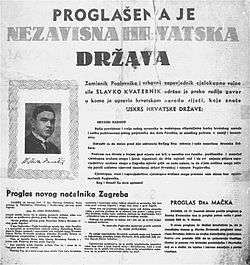
Following the 1938 Anschluss (union) of Germany with Austria, Yugoslavia shared a border with the Third Reich and came under increasing pressure as her neighbours became aligned with the Axis powers. In April 1939, Yugoslavia gained a second frontier with Italy when that country invaded and occupied neighbouring Albania.[12] At the outbreak of World War II, the Yugoslav government declared its neutrality.[13] Between September and November 1940, Hungary and Romania joined the Tripartite Pact, and Italy invaded Greece. From that time, Yugoslavia was almost completely surrounded by the Axis powers and their satellites, and her neutral stance toward the war came under tremendous pressure.[12] In late February 1941, Bulgaria joined the Pact. The next day, German troops entered Bulgaria from Romania, closing the ring around Yugoslavia.[14] With the aim of securing his southern flank for the pending attack on the Soviet Union, Adolf Hitler began placing heavy pressure on Yugoslavia to join the Axis powers. The Yugoslav government conditionally signed the Pact after some delay, on 25 March 1941. Two days later, a group of pro-Western Serb-nationalist air force officers deposed Prince Paul in a bloodless coup d'état. The conspirators declared 17-year-old Prince Peter of age and brought to power a government of national unity led by General Dušan Simović.[15] The coup enraged Hitler, who declared: "even if Yugoslavia at first should give declarations of loyalty, she must be considered as a foe and therefore must be destroyed as quickly as possible." He then ordered the invasion of Yugoslavia, which commenced on 6 April 1941.[16]
Đujić did not support the coup, and was in Strmica with his family when the Axis invasion began. He realised that Yugoslavia's collapse was inevitable after seeing a column of demoralised troops from the barely-mobilised 12th Infantry Division Jadranska pass his home. Once it became clear that the Royal Yugoslav Army (Serbo-Croatian: Vojska Kraljevine Jugoslavije, VKJ) could not hold the Axis advance, Đujić started blaming Croat fifth column activity for the VKJ's military defeats.[17] On 10 April 1941, the Ustaše-led Independent State of Croatia (Nezavisna Država Hrvatska, NDH) was proclaimed in Zagreb and divided into German and Italian zones of occupation.[18] Between April and August, NDH authorities implemented a policy of widespread incarcerations, massacres, forced emigration, and murder of Serbs.[19]
Collaboration agreements with the Italians
Following the NDH's establishment, Đujić narrowly escaped capture by the Ustaše.[5] As early as April, Đujić's Chetnik's began killing and mutilating Croats in retaliation for the wave of Ustaše atrocities against Serb communities across the NDH around the same time.[20][21] According to Italian reports, Đujić had around 300 Chetniks under his command that month, centered mainly around Knin. By mid-month, his Chetniks were launching raids against communist-held villages between Bosansko Grahovo and Drvar in conjunction with the Italians,[22] who considered him a filibuster.[23] His Chetniks successfully kept the Ustaše out of Knin and its surroundings, sparing the local Serb population from further massacres.[23]
As summer approached, Đujić's Chetniks captured Drvar from the Ustaše.[5] By early summer, he and Chetnik commander Stevo Rađenović had contacted the Italians and asked them to put a halt to the Ustaše mistreatment of Serbs, enable the return of Serb refugees, and repeal a decree that enabled the confiscation of Serb-owned property in the NDH. The Italians obliged in the hope that doing so would win the Chetniks over to collaboration and seriously weaken any future uprising in the area, which would have further disrupted rail traffic along the Split–Karlovac line.[24] On 13 August, at a meeting in the village of Pađene, Đujić and several other Serb nationalists agreed to collaborate with the Italians.[25] They secretly signed a pact of non-aggression with the Italian military, and in exchange, the Italians acquiesced to Đujić's 3,000 Chetniks operating in and around Knin.[22] On 31 August, at a Drvar assembly, Đujić was given the task of stopping the Italian advance on the town. Immediately afterwards, he made an agreement with the Italians granting them free passage.[25]
Establishment of the Dinara Division
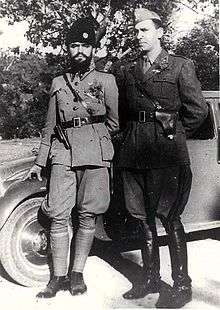
In early January 1942, the Dinara Division was formed after Đujić was contacted by Mihailović, via a courier. Under Mihailović's putative control, Ilija Trifunović-Birčanin played a central role in organising the units of Chetnik leaders in western Bosnia, Lika, and northern Dalmatia into the Dinara Division and dispatched former Royal Yugoslav Army officers to help. Đujić was designated the commander of the division with a goal of the "establishment of a Serb national state" in which "an exclusively Orthodox population is to live".[26] Đujić said the Dinara Division was "under Draža's command, but we received news and supplies for our struggle from Ljotić and [leader of the puppet government in occupied Serbia, Milan] Nedić. [...] Nedić's couriers reached me in Dinara and mine reached him in Belgrade. He sent me military uniforms for the guardists of the Dinara Chetnik Division; he sent me ten million dinars to obtain for the fighters whatever was needed and whatever could be obtained."[27]
By mid-April Đujić and his troops began collaborating with the Italians in anti-Partisan raids.[28] He operated in northern Dalmatia under Trifunović-Birčanin who acted as liaison officer between the Chetniks and Italians,[29] and whose collaboration agreements were condoned by Mihailović.[28] By June 1942, Đujić and other Chetnik leaders had established co-operation with the Ustaše, although these relationships were "based only on their common fear of the Partisans" and "characterised by distrust and uncertainty".[30] Đujić actively co-operated with Italian forces, with whom he had concluded a non-aggression pact. In late September 1942, Đujić's Chetniks killed up to 200 Croats in the village of Gata near Split, outraging the Italians.[31]
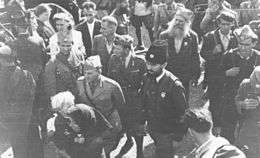
On 10 February 1943, Đujić, Ilija Mihić, Petar Baćović and Radovan Ivanišević, the Chetnik commanders of east Bosnia, Herzegovina, Dalmatia, and Lika, signed a joint proclamation declaring to the "people of Bosnia, Lika, and Dalmatia" that "since we have cleansed Serbia, Montenegro, and Herzegovina, we have come to help to crush the pitiful remnants of the Communist international, criminal band of Josip Broz Tito, Moša Pijade, Levi Vajnert and other paid Jews". The Partisan rank and file was called upon to "kill the political commissars and join our ranks right away," like the "hundreds and hundreds who are surrendering every day, conscious that they have been betrayed and swindled by the Communist Jews."[32]
Following the death of Trifunović-Birčanin in February 1943, Đujić, along with Dobroslav Jevđević, Baćović, and Ivanišević vowed to the Italians to carry on Trifunović-Birčanin's policies of closely collaborating with them against the Yugoslav Partisans.[29] Đujić's detachments in Dalmatia and western Bosnia were used by the Italians almost up to the point of their surrender.[33] Following Italian capitulation in September 1943, the Germans were less supportive of Đujić than the Italians had been and restricted his activities to guarding railway tracks from Partisan sabotage.[34] On 19 or 20 November 1943, Mihailović ordered Đujić to collaborate with the Germans, adding that he himself was unable to openly do so "because of public opinion."[35]
Retreat and surrender
On 25 November 1944, the Yugoslav Partisans attacked the town of Knin, which was defended by 14,000 German troops, 4,500 of Đujić's Chetniks, and around 1,500 Ustaše. On 1 December, Đujić was wounded and sent an emissary to General Gustav Fehn of the German 264th Infantry Division in Knin with the following message:[34]
The Chetnik Command with all of its armed forces has collaborated sincerely and loyally with the German Army in these areas from September last year. Our common interest demanded this. This collaboration has continued to the present day. [...] The Chetnik Command wishes to share the destiny of the German Army in the future, too. [...] The Command requests that [the village of] Pađene be the base for supplying our units, until a further common agreement is reached.
On 3 December 1944, Đujić's force of between 6,000 and 7,000 withdrew to Bihać with help from the Wehrmacht 373rd Infantry Division. The Chetniks received ammunition and food from the Germans and began a joint German-Chetnik offensive against the Partisans. General Fehn organised the transportation of Đujić's wounded Chetniks through Zagreb to the Third Reich. Đujić requested a written guarantee from Ante Pavelić, leader of the NDH, to afford him and his forces refuge in German-occupied Slovenia. In addition, Ljotić and Milan Nedić petitioned to Nazi party official Hermann Neubacher in Vienna that Đujić's forces should be allowed passage, as did Slovene collaborationist General Leon Rupnik.[34]
On 21 December 1944, Pavelić ordered the military forces of the NDH to give Đujić and his forces "orderly and unimpeded passage".[36] However, Đujić took an alternate route towards the Istrian peninsula, as the routes offered by Pavelić were not secure from Partisan attacks. When Đujić reached Slovenia, his forces joined Jevđević's Chetniks, Ljotić's Serbian Volunteer Corps, and Nedić's Serbian Shock Corps, forming a single unit that was under the command of Odilo Globocnik, the Higher SS and Police Leader in the Adriatic Littoral.[34] Together, they tried to contact the western Allies in Italy in an attempt to secure foreign aid for a proposed anti-Communist offensive to restore royalist Yugoslavia.[37] In May 1945, Đujić surrendered his division to Allied forces and they were then taken to southern Italy, from there to displaced persons camps in Germany and then dispersed.[5]
Life in exile
In 1947, Đujić was tried and sentenced in absentia for war crimes by Yugoslavia.[38] He was declared a war criminal who, as commander of the Dinara Division, was responsible for organising and carrying out a series of mass murders, massacres, tortures, rapes, robberies, and imprisonments, and collaborating with the German and Italian occupiers.[39] He was accused of being responsible for the deaths of 1,500 people during the war.[5]
From 1947 to 1949 Đujić lived in Paris, before emigrating to the United States,[5] and many of his former Chetniks followed him.[40] Following his arrival in the United States, Đujić and his fighters played a role in the foundation of the Ravna Gora Movement of Serbian Chetniks.[40][38] Later, he enraged some in the Serbian diaspora when he endorsed a Communist-authorised Patriarch of the Serbian Orthodox Church. However, he remained strongly opposed to the Communist regime in Yugoslavia. Đujić retired to San Marcos, where he wrote poems and jokes that were published in both the United States and Serbia.[5] On several occasions the Yugoslav authorities sought his extradition from the United States to face war crimes charges, but these requests were always rejected.[38]
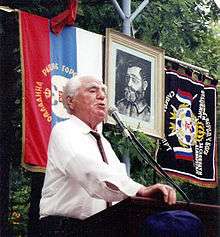
On 28 June 1989, the 600th anniversary of the Battle of Kosovo, Đujić granted the title of vojvoda to Vojislav Šešelj,[41] and ordered him "to expel all Croats, Albanians, and other foreign elements from holy Serbian soil", stating he would return only when Serbia was cleansed of "the last Jew, Albanian, and Croat".[42] Šešelj was at the time an anti-Communist dissident. The writer and political analyst Paul Hockenos subsequently described Šešelj's activities in the Yugoslav Wars as "a man whose killer commando units operating in Croatia and Bosnia carried on the very worst of the Chetnik tradition."[40] Later Šešelj became leader of the Serbian Radical Party, a government coalition partner of Serbian President Slobodan Milosević. In 1998, Đujić publicly stated that he regretted awarding that title to Šešelj. He was quoted as saying, "I was naïve when I nominated Šešelj [as] Vojvoda; I ask my people to forgive me. The greatest gravedigger of Serbdom is Slobodan Milošević"[5] and that he was "disappointed in Šešelj for openly collaborating with Milošević's Socialist Party, with Communists who have only changed their name. [...] Šešelj has sullied the reputation of Chetniks and Serbian nationalism."[43]
According to the International Criminal Tribunal for the former Yugoslavia (ICTY) testimony of Croatian Serb leader Milan Babić, Đujić financially supported the Republic of Serbian Krajina in the 1990s.[44] Đujić's wife Zorka died on 23 August 1995, aged 84.[5] On 21 May 1998, Biljana Plavšić, President of the Republika Srpska at the time, awarded Đujić the Order of the Star of Karađorđe (First Class).[45][46][47] On 28 May 1999, the Croatian Justice Minister Zvonimir Šeparović attempted to have Đujić extradited based on lengthy evidence drawn from proceedings carried out by the Šibenik-Knin County Court, but to no avail.[48]
Death
Đujić died on 11 September 1999 at a hospice in San Diego, California at the age of 92. He was survived by his three children, two granddaughters, four great-grandchildren, his brother, Boško Đujić, and his sister, Ilinka Đuric, all of whom were residents of California.[5] A New York Times obituary following his death, written by the journalist David Binder, wrote that Đujić was "a fierce foe of the Nazis, Fascists and Communists," who participated in "epic World War II battles" and carried out many "acts of wartime bravery."[49] The article and its author were criticised by the Croatian government which said it was "dissatisfied and disappointed" with what it stated was "false" information included in Đujić's biography.[48] Editorial writer for the Washington Post, Benjamin Wittes, observed that the obituary only mentioned "in passing" the war crimes and collaboration accusations against Đujić, as well as his influence in the Yugoslav Wars.[49] The historian Marko Attila Hoare stated that Binder's piece displayed his "admiration of Serb Nazi-collaborator Momčilo Đujić."[50]
A commemoration marking six months since Đujić's death, organized by the "Vojvoda Momčilo Đujić" Dinara Chetnik Movement, was celebrated at St. Mark's Church in Belgrade in March 2000.[51][52] The Serbian diaspora in the United States set up a monument dedicated to Đujić at the Serbian cemetery in Libertyville, Illinois. The management and players of the football club Red Star Belgrade visited the monument on 23 May 2010.[53]
Notes
- 1 2 3 Popović, Lolić & Latas 1988, p. 9.
- ↑ Hoare 2006, p. 129.
- 1 2 3 Popović, Lolić & Latas 1988, p. 10.
- 1 2 3 4 5 Popović, Lolić & Latas 1988, p. 11.
- 1 2 3 4 5 6 7 8 9 10 11 12 Binder 13 September 1999.
- 1 2 Popović, Lolić & Latas 1988, p. 12.
- ↑ Popović, Lolić & Latas 1988, p. 16, note 1.
- 1 2 Popović, Lolić & Latas 1988, p. 13.
- ↑ Popović, Lolić & Latas 1988, pp. 14–15.
- 1 2 Popović, Lolić & Latas 1988, p. 16.
- ↑ Popović, Lolić & Latas 1988, p. 15.
- 1 2 Roberts 1973, pp. 6–7.
- ↑ Pavlowitch 2008, p. 8.
- ↑ Roberts 1973, p. 12.
- ↑ Pavlowitch 2008, pp. 10–13.
- ↑ Roberts 1973, p. 15.
- ↑ Popović, Lolić & Latas 1988, p. 18.
- ↑ Tomasevich 2001, pp. 105, 233.
- ↑ Ramet 2006, p. 120.
- ↑ Cohen 1996, p. 45.
- ↑ Pinson 1994, p. 143.
- 1 2 Milazzo 1975, p. 76.
- 1 2 Pavlowitch 2008, p. 46.
- ↑ Ramet 2006, p. 147.
- 1 2 Hoare 2006, pp. 135–136.
- ↑ Hoare 2006, p. 291.
- ↑ Hoare 2006, p. 293.
- 1 2 Ramet 2006, p. 148.
- 1 2 Tomasevich 1975, p. 218.
- ↑ Ramet 2006, p. 129.
- ↑ Judah 2001, p. 129.
- ↑ Hoare 2006, p. 162.
- ↑ Judah 2001, p. 262.
- 1 2 3 4 Cohen 1996, pp. 45–47.
- ↑ Tomasevich 1975, p. 329.
- ↑ Tomasevich 2001, p. 442.
- ↑ Tomasevich 1969, p. 111.
- 1 2 3 Washington Times 14 September 1999.
- ↑ Popović, Lolić & Latas 1988, p. 7.
- 1 2 3 Hockenos 2003, p. 119.
- ↑ ICTY 7 December 2007.
- ↑ Velikonja 2003, p. 246.
- ↑ Silber 1993.
- ↑ ICTY 4 December 2002.
- ↑ BBC 21 May 1998.
- ↑ Bosworth 2009, p. 431.
- ↑ Hoare 1999.
- 1 2 BBC 16 September 1999.
- 1 2 Wittes 1999.
- ↑ Hoare 2007.
- ↑ Glas javnosti 3 March 2000.
- ↑ Kotaraš 2002.
- ↑ Gudžević 2010.
References
- Binder, David (13 September 1999). "Momcilo Djujic, Serbian Priest and Warrior, Dies at 92". New York Times.
- "Bosnian Serb president in USA, decorates exiled Serb nationalist leader". BBC. 21 May 1998.
- Bosworth, R.J.B. (2009). The Oxford Handbook of Fascism. Oxford: Oxford University Press. ISBN 978-0-19-929131-1.
- Cohen, Philip J. (1996). Serbia's Secret War: Propaganda and the Deceit of History. College Station: Texas A&M University Press. ISBN 978-0-89096-760-7.
- "Croatian ministry complains about US paper's coverage of Chetnik war criminal". BBC. 16 September 1999.
- Gudžević, Sinan (18 June 2010). "Na kapi zvezda, u glavi kokarda" [A Star on their Cap, a Cockade on their Mind]. e-Novine (in Serbo-Croatian).
- Hoare, Marko Attila (January–March 1999). "Bosnian Serbs and Anti-Bosnian Serbs". Bosnia Report. 8. Bosnian Institute.
- Hoare, Marko Attila (2006). Genocide and Resistance in Hitler's Bosnia: The Partisans and the Chetniks 1941–1943. New York: Oxford University Press. ISBN 978-0-19-726380-8.
- Hoare, Marko Attila (30 November 2007). "Monty Python and the Balkan Islamofascist division". Bosnia Report. Bosnian Institute.
- Hockenos, Paul (2003). Homeland Calling: Exile Patriotism and the Balkan Wars. Ithaca: Cornell University Press. ISBN 978-0-8014-4158-5.
- Judah, Tim (2001). The Serbs: History, Myth and the Destruction of Yugoslavia. New Haven: Yale University Press. ISBN 978-0-300-08507-5.
- Kotaraš, Stevo P. (23 September 2002). "Čudna beseda" [Strange Faith]. Glas javnosti (in Serbo-Croatian).
- Milazzo, Matteo J. (1975). The Chetnik Movement & the Yugoslav Resistance. Baltimore, Maryland: Johns Hopkins University Press. ISBN 978-0-8018-1589-8.
- "Parastos vojvodi Đujiću" [Dirge for Vojvoda Đujić]. Glas javnosti (in Serbo-Croatian). 3 March 2000.
- Pavlowitch, Stevan K. (2008). Hitler's New Disorder: The Second World War in Yugoslavia. New York: Columbia University Press. ISBN 978-1-85065-895-5.
- Pinson, Mark (1994). The Muslims of Bosnia-Herzegovina: Their Historic Development from the Middle Ages to the Dissolution of Yugoslavia. Cambridge, Massachusetts: Harvard University Press. ISBN 0-932885-09-8.
- Popović, Jovo; Lolić, Marko; Latas, Branko (1988). Pop izdaje: četnički vojvoda Momčilo Đujić [Father Issues: The Chetnik Vojvoda Momčilo Đujić] (PDF) (in Serbo-Croatian). Zagreb: Stvarnost. ISBN 978-86-7075-039-5.
- "Prosecutor v. Slobodan Milosević (Transcript)". International Criminal Tribunal for the former Yugoslavia (ICTY). 4 December 2002. IT-02-54-T.
- "Prosecutor v. Vojislav Šešelj (Third Amended Indictment)" (PDF). International Criminal Tribunal for the former Yugoslavia (ICTY). 7 December 2007. IT-03-67.
- Ramet, Sabrina P. (2006). The Three Yugoslavias: State-Building and Legitimation, 1918–2005. Bloomington: Indiana University Press. ISBN 978-0-253-34656-8.
- Roberts, Walter R. (1973). Tito, Mihailović and the Allies 1941–1945. Durham, North Carolina: Duke University Press. ISBN 978-0-8223-0773-0.
- Samardžić, Miloslav (2014). Vojvoda Đujić i Dinarska četnička divizija [Vojvoda Đujić and the Chetnik Dinara Division] (in Serbo-Croatian). NIP Pogledi. ISBN 978-86-82235-84-2.
- "Serb Leader Momcilo Djujic Dies; Led Chetniks During World War II". Washington Times. 14 September 1999.
- Silber, Laura (3 August 1993). "Serbia's Ultranationalist Leader Emerges as Formidable Political Force". Los Angeles Times.
- Tomasevich, Jozo (1969). "Yugoslavia During the Second World War". In Vucinich, Wayne S. Contemporary Yugoslavia: Twenty Years of Socialist Experiment. Berkeley, California: University of California Press. OCLC 652337606.
- Tomasevich, Jozo (1975). War and Revolution in Yugoslavia, 1941–1945: The Chetniks. Stanford: Stanford University Press. ISBN 978-0-8047-0857-9.
- Tomasevich, Jozo (2001). War and Revolution in Yugoslavia, 1941–1945: Occupation and Collaboration. Stanford: Stanford University Press. ISBN 978-0-8047-3615-2.
- Velikonja, Mitja (2003). Religious Separation and Political Intolerance in Bosnia-Herzegovina. College Station: Texas A&M University Press. ISBN 978-1-58544-226-3.
- Wittes, Benjamin (20 September 1999). "For an Accused War Criminal, a 50-Year Haven in America". Washington Post.
| Wikimedia Commons has media related to Momčilo Đujić. |
